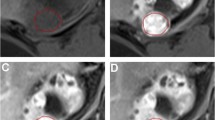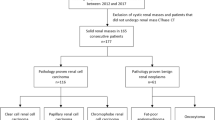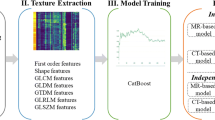Abstract
Purpose
The study evaluated the usefulness of magnetic resonance imaging (MRI) texture parameters in differentiating clear cell renal carcinoma (CC-RCC) from non-clear cell carcinoma (NC-RCC) and in the histological grading of CC-RCC.
Materials and methods
After institutional ethical approval, this retrospective study analyzed 33 patients with 34 RCC masses (29 CC-RCC and five NC-RCC; 19 low-grade and 10 high-grade CC-RCC), who underwent MRI between January 2011 and December 2012 on a 1.5-T scanner (Avanto, Siemens, Erlangen, Germany). The MRI protocol included T2-weighted imaging (T2WI), diffusion-weighted imaging [DWI; at b 0, 500 and 1000 s/mm2 with apparent diffusion coefficient (ADC) maps] and T1-weighted pre and postcontrast [corticomedullary (CM) and nephrographic (NG) phase] acquisition. MR texture analysis (MRTA) was performed using the TexRAD research software (Feedback Medical Ltd., Cambridge, UK) by a single reader who placed free-hand polygonal region of interest (ROI) on the slice showing the maximum viable tumor. Filtration histogram-based texture analysis was used to generate six first-order statistical parameters [mean intensity, standard deviation (SD), mean of positive pixels (MPP), entropy, skewness and kurtosis] at five spatial scaling factors (SSF) as well as on the unfiltered image. Mann–Whitney test was used to compare the texture parameters of CC-RCC versus NC-RCC, and high-grade versus low-grade CC-RCC. P value < 0.05 was considered significant. A 3-step feature selection was used to obtain the best texture metrics for each MRI sequence and included the receiver-operating characteristic (ROC) curve analysis and Pearson’s correlation test.
Results
The best performing texture parameters in differentiating CC-RCC from NC-RCC for each sequence included (area under the curve in parentheses): entropy at SSF 4 (0.807) on T2WI, SD at SSF 4 (0.814) on DWI b500, SD at SSF 6 (0.879) on DWI b1000, mean at SSF 0 (0.848) on ADC, skewness at SSF 2 (0.854) on T1WI and skewness at SSF 3 (0.908) on CM phase. In differentiating high from low-grade CC-RCC, the best parameters were: entropy at SSF 6 (0.823) on DWI b1000, mean at SSF 3 (0.889) on CM phase and MPP at SSF 5 (0.870) on NG phase.
Conclusion
Several MR texture parameters showed excellent diagnostic performance (AUC > 0.8) in differentiating CC-RCC from NC-RCC, and high-grade from low-grade CC-RCC. MRTA could serve as a useful non-invasive tool for this purpose.




Similar content being viewed by others

References
Bray F, Ferlay J, Soerjomataram I, Siegel RL, Torre LA, Jemal A. Global cancer statistics 2018: GLOBOCAN estimates of incidence and mortality worldwide for 36 cancers in 185 countries. CA Cancer J Clin. 2018 Nov 1;68(6):394–424.
Capitanio U, Montorsi F. Renal cancer. Lancet Lond Engl. 2016 Feb 27;387(10021):894–906
Volpe A, Patard JJ. Prognostic factors in renal cell carcinoma. World J Urol. 2010 Jun;28(3):319–27
Ficarra V, Righetti R, Martignoni G, D’Amico A, Pilloni S, Rubilotta E, et al. Prognostic value of renal cell carcinoma nuclear grading: multivariate analysis of 333 cases. Urol Int. 2001;67(2):130–4
Muglia VF, Prando A. Renal cell carcinoma: histological classification and correlation with imaging findings. Radiol Bras. 2015;48(3):166–74
Posadas EM, Limvorasak S, Figlin RA. Targeted therapies for renal cell carcinoma. Nat Rev Nephrol. 2017 Jul 10;13:496
Corapi KM, Chen JLT, Balk EM, Gordon CE. Bleeding complications of native kidney biopsy: a systematic review and meta-analysis. Am J Kidney Dis Off J Natl Kidney Found. 2012 Jul;60(1):62–73
Andersen MFB, Norus TP. Tumor Seeding With Renal Cell Carcinoma After Renal Biopsy. Urol Case Rep. 2016 Sep 25;9:43–4
Posadas EM, Figlin RA. Kidney cancer: progress and controversies in neoadjuvant therapy. Nat Rev Urol. 2014 May;11(5):254–5
Wu Y, Kwon YS, Labib M, Foran DJ, Singer EA. Magnetic Resonance Imaging as a Biomarker for Renal Cell Carcinoma. Dis Markers [Internet]. 2015 [cited 2019 Apr 8];2015. Available from: https://www.ncbi.nlm.nih.gov/pmc/articles/PMC4644550/
Goyal A, Sharma R, Bhalla AS, Gamanagatti S, Seth A, Iyer VK, et al. Diffusion-weighted MRI in renal cell carcinoma: a surrogate marker for predicting nuclear grade and histological subtype. Acta Radiol Stockh Swed 1987. 2012 Apr 1;53(3):349–58.
Lubner MG, Smith AD, Sandrasegaran K, Sahani DV, Pickhardt PJ. CT Texture Analysis: Definitions, Applications, Biologic Correlates, and Challenges. Radiogr Rev Publ Radiol Soc N Am Inc. 2017 Oct;37(5):1483–503.
Raman SP, Chen Y, Schroeder JL, Huang P, Fishman EK. CT texture analysis of renal masses: pilot study using random forest classification for prediction of pathology. Acad Radiol. 2014 Dec;21(12):1587–96
Lubner MG, Stabo N, Abel EJ, del Rio AM, Pickhardt PJ. CT Textural Analysis of Large Primary Renal Cell Carcinomas: Pretreatment Tumor Heterogeneity Correlates With Histologic Findings and Clinical Outcomes. Am J Roentgenol. 2016 May 4;207(1):96–105
Kierans AS, Rusinek H, Lee A, Shaikh MB, Triolo M, Huang WC, et al. Textural differences in apparent diffusion coefficient between low- and high-stage clear cell renal cell carcinoma. AJR Am J Roentgenol. 2014 Dec;203(6):W637-644
Yu H, Scalera J, Khalid M, Touret A-S, Bloch N, Li B, et al. Texture analysis as a radiomic marker for differentiating renal tumors. Abdom Radiol N Y. 2017;42(10):2470–8
Zhang G-M-Y, Shi B, Xue H-D, Ganeshan B, Sun H, Jin Z-Y. Can quantitative CT texture analysis be used to differentiate subtypes of renal cell carcinoma? Clin Radiol. 2019 Apr;74(4):287–94.
Bektas CT, Kocak B, Yardimci AH, Turkcanoglu MH, Yucetas U, Koca SB, et al. Clear Cell Renal Cell Carcinoma: Machine Learning-Based Quantitative Computed Tomography Texture Analysis for Prediction of Fuhrman Nuclear Grade. Eur Radiol. 2019 Mar;29(3):1153–63
Shu J, Tang Y, Cui J, Yang R, Meng X, Cai Z, et al. Clear cell renal cell carcinoma: CT-based radiomics features for the prediction of Fuhrman grade. Eur J Radiol. 2018 Dec;109:8–12
Kocak B, Yardimci AH, Bektas CT, Turkcanoglu MH, Erdim C, Yucetas U, et al. Textural differences between renal cell carcinoma subtypes: Machine learning-based quantitative computed tomography texture analysis with independent external validation. Eur J Radiol. 2018 Oct 1;107:149–57
Vendrami CL, Velichko YS, Miller FH, Chatterjee A, Villavicencio CP, Yaghmai V, et al. Differentiation of Papillary Renal Cell Carcinoma Subtypes on MRI: Qualitative and Texture Analysis. Am J Roentgenol. 2018 Sep 21;211(6):1234–45
Miles KA, Ganeshan B, Hayball MP. CT texture analysis using the filtration-histogram method: what do the measurements mean? Cancer Imaging. 2013 Sep 23;13(3):400–6
Hodgdon T, McInnes MDF, Schieda N, Flood TA, Lamb L, Thornhill RE. Can Quantitative CT Texture Analysis be Used to Differentiate Fat-poor Renal Angiomyolipoma from Renal Cell Carcinoma on Unenhanced CT Images? Radiology. 2015 Sep;276(3):787–96
Vikram R, Ng CS, Tamboli P, Tannir NM, Jonasch E, Matin SF, et al. Papillary Renal Cell Carcinoma: Radiologic-Pathologic Correlation and Spectrum of Disease. RadioGraphics. 2009 May 1;29(3):741–54
Woo S, Suh CH, Kim SY, Cho JY, Kim SH. Diagnostic Performance of DWI for Differentiating High- From Low-Grade Clear Cell Renal Cell Carcinoma: A Systematic Review and Meta-Analysis. Am J Roentgenol. 2017 Oct 12;209(6):W374–81
Author information
Authors and Affiliations
Contributions
Study concepts and design: AG, AR, DK, RS; Data acquisition: AG, AR, PD; Data analysis and interpretation: AG, AR, DK, BG, RS; Literature research: AG, AR, RS; Manuscript drafting: AG, AR; Manuscript revision for important intellectual content: AG, AR, DK, BG, RS; Approval of the final version of the submitted manuscript: all authors.
Corresponding author
Ethics declarations
Conflict of interest
One of the authors (Balaji Ganeshan) is a director and part time employee of Feedback Medical Ltd., a UK based company which develops and markets the TexRAD texture analysis software used in this study. All the other authors are from the All India Institute of Medical Sciences, New Delhi, India and certify that we had complete control over the study and the results submitted.
Additional information
Publisher's Note
Springer Nature remains neutral with regard to jurisdictional claims in published maps and institutional affiliations.
Rights and permissions
About this article
Cite this article
Goyal, A., Razik, A., Kandasamy, D. et al. Role of MR texture analysis in histological subtyping and grading of renal cell carcinoma: a preliminary study. Abdom Radiol 44, 3336–3349 (2019). https://doi.org/10.1007/s00261-019-02122-z
Published:
Issue Date:
DOI: https://doi.org/10.1007/s00261-019-02122-z



